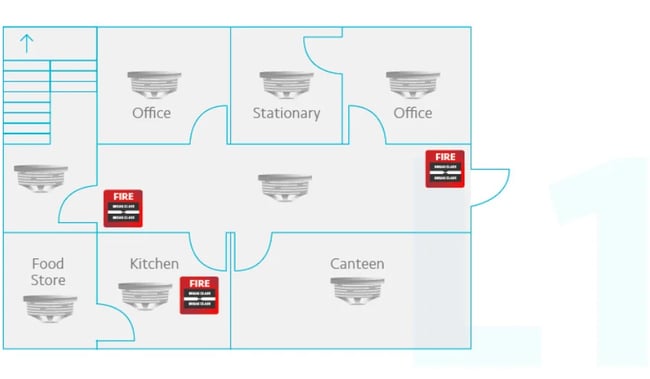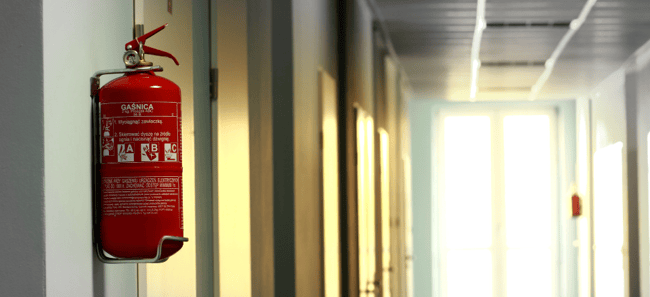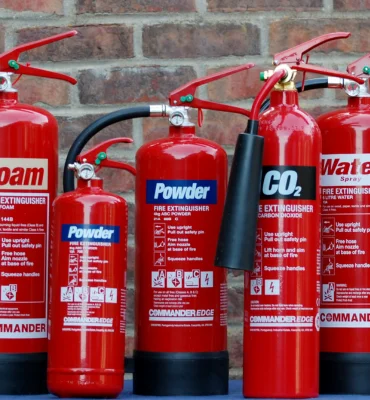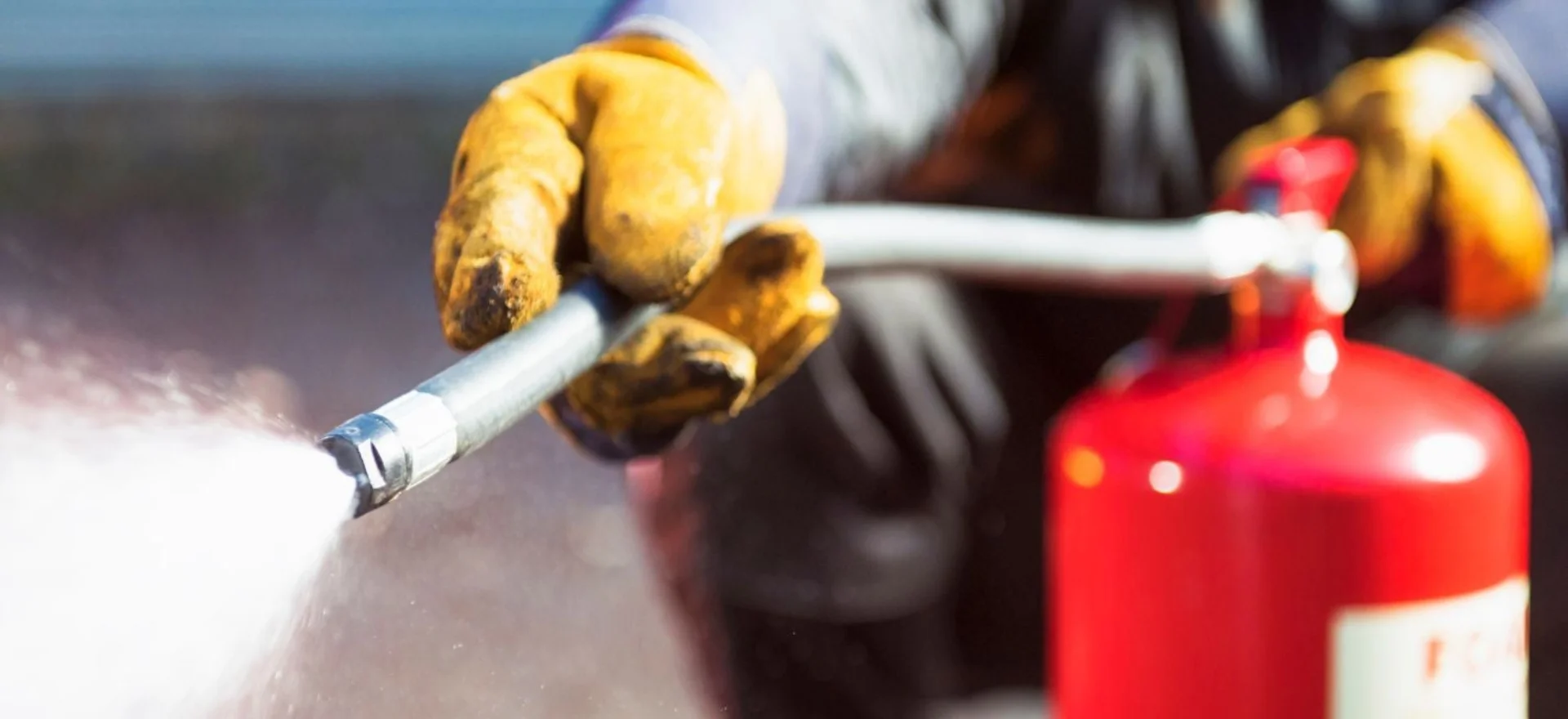Fire extinguishers are a crucial piece of fire safety equipment. They can be the difference between a small fire that is nipped in the bud, and one that quickly spreads out of control, causing huge amounts of damage, and possibly putting lives at risk.
No fire extinguisher is suitable for every type of fire, however. Using the wrong one is, at best, ineffective, and at worst can spread the fire even faster.
Jump To
- Water & Aqua-Spray Fire Extinguishers
- Foam Fire Extinguishers
- Dry Powder Fire Extinguishers
- CO2 Fire Extinguishers
- Wet Chemical Fire Extinguishers
- Final Thoughts
So, to help you decide which type of fire extinguisher best suits your needs, we've created a comprehensive run-down of each type of extinguisher. This includes how they work and how to use them, what types of fire they should and should not be used on, and why.

Water & Aqua-Spray Fire Extinguishers
Water fire extinguishers should be used on “Class A”, or combustible solid fires that involve materials such as wood, paper, fabrics, furniture, plastics, etc., so-called "carbonaceous" materials.
To use a water extinguisher, point the extinguisher nozzle at the burning material, then squeeze the handles. Spray the water back and forth in a sweeping pattern to ensure maximum coverage.
Water is especially useful against Class A fires because they have a relatively low ignition point it both cools and soaks the fuel, bringing it below its ignition point, while also blocking oxygen
Though water mist extinguishers are very effective at tackling combustible solid fires, they should not be used on gas (Class B), liquid (Class C), combustible metal (Class D), electrical or cooking oil/fat fires (Class F).

Almost all flammable liquids are less dense than water, so they will just sit on top of it, still burning, and the fire may even be spread as the water carries them further. When sprayed at an electrical fire, the stream of water may create a direct path to the user, shocking or even electrocuting them, as well as damaging any otherwise unscathed electrical components.
Most importantly, water extinguishers should never be used on cooking oil/fat fires. When water hits the super-heated oil, it will start to boil, as well as sink below the surface. The steam produced will rise and carry the super-heated oil with it, which will immediately catch fire on contact with the air, creating a column of flame.
Foam Fire Extinguishers
A foam or Aqueous Film Forming Foam (AFFF) fire extinguisher shoots a jet of pressurised, water-based foam. This foam forms a thick blanket over the surface of a fire to suppress the flames and prevent flammable vapours from being released. As with a water extinguisher, point the nozzle at the base of the fire, then spray back and forward in a sweeping motion to cover the entirety of the fuel.
Like the water-based variety, a foam extinguisher is very effective against Class A fires. The foam smothers the flames, and lowers the temperature of the fuel, so it won’t reignite. Unlike water, the low density of the foam makes it suitable for use on burning liquids (Class B fires) too. Rather than sinking, the foam sits on top of the liquid, cutting it off from its oxygen supply while preventing flammable vapours from escaping and reigniting. Foam extinguishers aren’t effective against gas fires, and are dangerous to use on metal, electrical and cooking oil fires.

Extinguisher foam contains water, which can react with the burning metal to release flammable hydrogen, intensifying the fire. Metal fires also occur at very high temperatures, and foam will not be able to cool them to the point that they won’t reignite.
As with water, foam also conducts electricity, which makes it an electrocution risk, and it can damage or destroy otherwise salvageable electrical materials.
Extinguisher foam can also accelerate cooking oil fires much like water. It is poor at cooling as well, so may not lower the oil below self-ignition temperature by the time it disperses.

Dry Powder Fire Extinguishers
A dry powder fire extinguisher releases a fine chemical powder, typically monoammonium phosphate or ammonium sulphate. This powder expands in the heat created by a fire and coagulates to create a barrier between the burning fuel and its oxygen supply, smothering the flames. Point the nozzle at the base of the fire and sweep the spray back and forth, so the powder can cover all the flammable material.
Probably the most versatile option, dry powder extinguishers can be used on material, liquid and gas fires (Classes A, B & C), as well as electrical fires.
The powder forms a barrier over Class A, B & C fires, cutting off the oxygen supply, smothering the flames.
As the powder is not electrically conductive, it is effective on electrical fires. However, it does leave a significant amount of residue, which can damage sensitive electrical equipment.
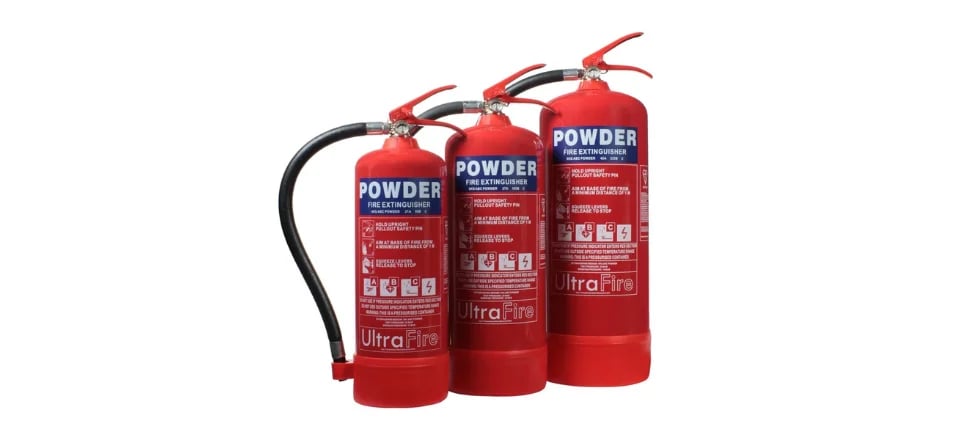
Powder extinguishers should not be used on metal fires (Class D). Class D fires need to be cooled below their ignition point to be fully extinguished, and powder does not have a significant cooling effect. There is also a risk of reaction as many metals responsible for these fires are highly reactive. These reactions can release flammable gases and exacerbate, rather than suppress the fire.
Dry powder should also not be used on oil/fat fires. It has very little in the way of a cooling effect, will not form a sufficient barrier on the surface of the oil, and the pressurised spray may splash the oil and spread the fire further.
Finally, most cooking oil fires happen in relatively enclosed areas, and the powder used in an extinguisher is an irritant when inhaled, potentially incapacitating the user in the process of dousing the fire.
.webp?width=960&height=440&name=Dry%20Powder%20Fire%20Extinguisher%20In%20Use%20(1).webp)
CO2 Fire Extinguishers
A Carbon Dioxide (CO2) extinguisher releases pressurised carbon dioxide, which quickly displaces oxygen around the fire, smothering the flames. To use, point the horn of the extinguisher at the base of the fire then sweep back and forward to cover the entire area. However, do not hold the horn, as it becomes extremely cold during discharge. This could cause the user’s hand to stick to the horn and may even result in frostbite.
CO2 is effective against flammable liquid fires. It displaces oxygen in the area surrounding the fuel and - since it is denser than air - it will also sink. This means the concentration of CO2 low down will still be high, even as it disperses, so the liquid will be prevented from reigniting.
CO2 is also non-conductive and leaves no residue, so it can be used to douse electrical fires with no risk of shock or causing permanent damage to electrical equipment. CO2 also leaves no residue, so it can be used to douse flames around electrical equipment with no risk of causing permanent damage.
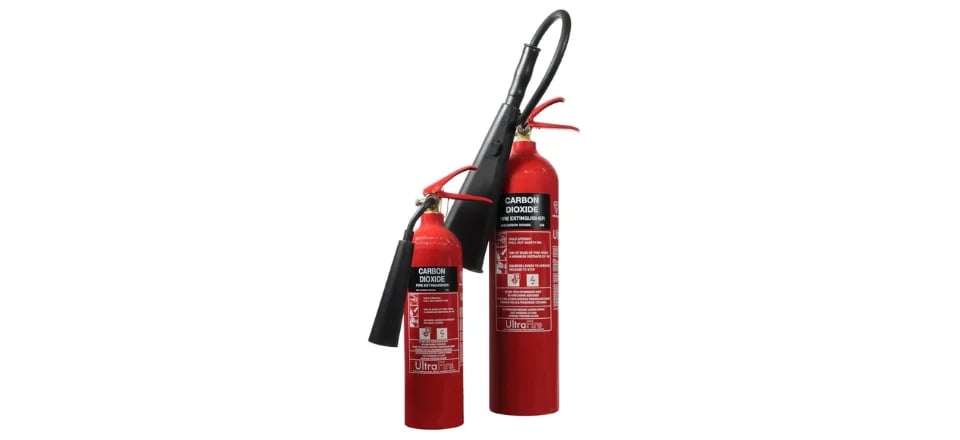
Carbon dioxide extinguishers should not be used on Class A, C, D or F fires. For Class A fires the main extinguishing action is cooling the burning material. CO2 extinguishers do produce some cooling effect, but this isn’t enough to prevent the fire reigniting.
Metal fires (class D) do not need atmospheric oxygen to sustain combustion. Since CO2 extinguishers work principally by displacing oxygen, they are ineffective in dealing with metal fires. CO2 also reacts with metals like lithium and magnesium at high temperatures, and this reaction can intensify the fire.

Wet Chemical Fire Extinguishers
A wet chemical fire extinguisher is specifically designed to tackle cooking oil, fat and grease fires. They contain a strong alkaline (or basic) chemical which reacts with the cooking fat to form a soapy, foam-like substance, in a process called “saponification”. This substance forms a film over the surface of the fat, cutting it off from its oxygen supply and smothering the flames in the process.
Unlike other extinguishers, a wet chemical fire extinguisher should not be pointed at the base of the fire, as this could cause the oil to splash and spread the fire. Instead, aim above the flames, so the liquid can fall back down onto the surface of the oil. Apply the spray in slow, circular motions to ensure complete coverage.
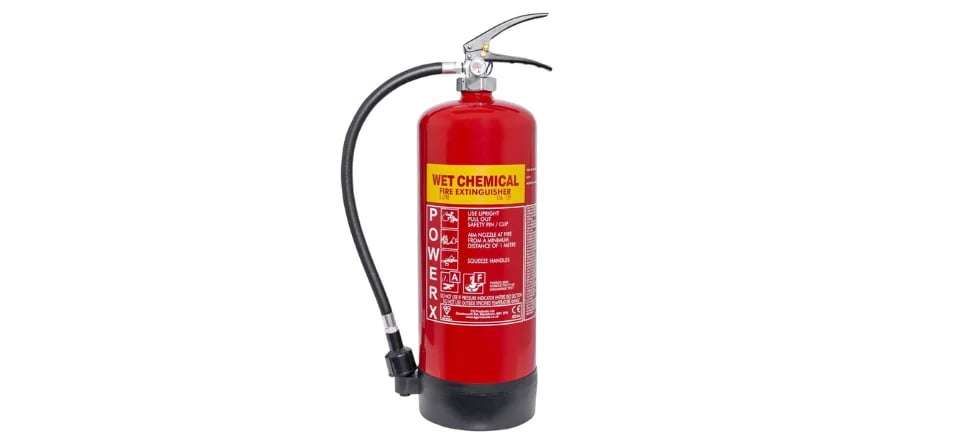
Wet chemical extinguishers should not be used against Class A, B, C, D or electrical fires because the chemicals used don’t produce enough of a cooling effect to prevent Class A fires from reigniting. They also won’t sit on top of burning liquids (Class B), and will simply disperse them, increasing the area of the fire.
Burning metals may also react with the wet chemical in an unpredictable manner, either intensifying metal fires, or producing dangerous gases.
.webp?width=960&height=440&name=Wet%20Chemical%20Fire%20Extinguisher%20(1).webp)
Final Thoughts
The ideal extinguisher for your situation will depend on the fire hazards present in your environment. If you run a restaurant or you are looking for an extinguisher for your home kitchen, you should opt for a wet chemical extinguisher. If you manage a business that uses flammable liquids, a dry powder or foam extinguisher would suit you better.
If you are uncertain of what the biggest fire hazards in your workplace are, we’re here to help. Chris Lewis Fire & Security have been safeguarding homes, campuses and businesses from fires for over 30 years.
If you would like to learn more about our fire protection or fire risk assessment offerings, simply fill out the form below, and one of our experts will be in contact.
Looking for state-of-the-art fire protection for your home, business or school? Get in touch with our experts today:
Submit the form below and we will reach out to you shortly.

Luke Lewis-Rippington
Related Posts
Fire Alarm Monitoring: The Benefits and Costs
Fire brigade callouts rose by over 11% last year, to the highest number in a decade, with UK Fire Services called out over 700,000 times. It seems like - after a fall during the pandemic - building.
Everything You Need to Know About Fire Alarm Systems, Explained
There’s lots to consider when looking to install or upgrade a fire alarm system. In order to make things a little easier, and to simplify the information that’s out there, in this blog we talk about.
Fire Safety in Schools: Your Responsibilities
Despite routine fire drills and regular testing, school fires still happen - and they can be fatal. Last year alone, uncontrolled building fires caused approximately 272 fatalities in the UK, many of.


